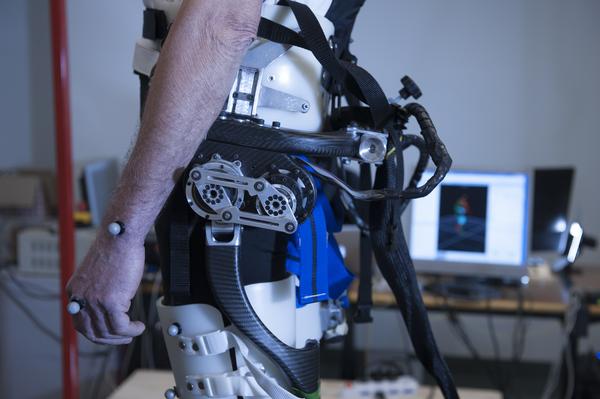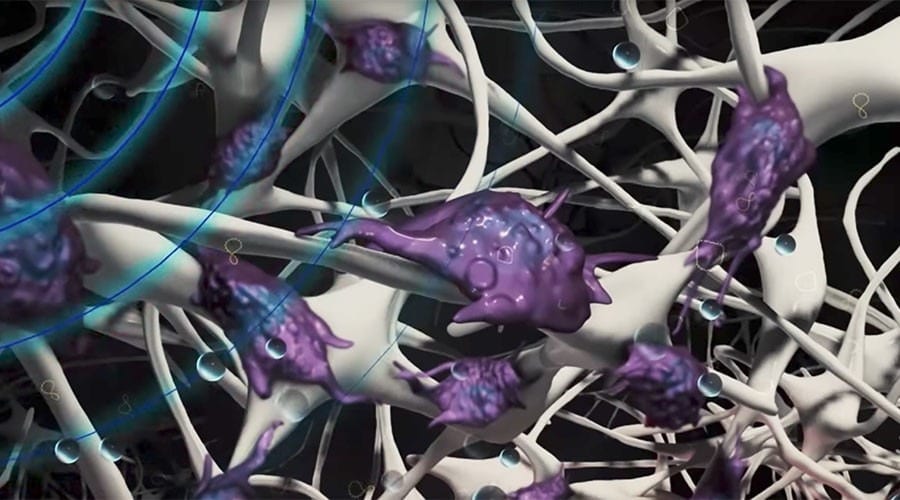
A powered exoskeleton prevents the elderly from falling
Wearable machines that enhance your movement and endurance no longer belong to the realm of science fiction. They are being developed today in the laboratory, and in this controlled setting, already prevent the elderly from falling.
Scientists at Scuola Sant’Anna in Italy and EPFL (Ecole polytechnique fédérale de Lausanne) in Switzerland have built a prototype of a smart, light-weight and easy-to-personalize exoskeleton that counteracts the loss of balance and promotes balance recovery after an accidental slip. This is a first in wearable machines, which are normally used to assist or enhance regular movement, instead of preventing an unexpected event like falling. The results are published on May 11th in Scientific Reports.
The exoskeleton was designed to help the elderly by preventing fall-related injuries, since seniors are involved in 40% of fatal injuries related to falling in Europe. But the exoskeleton could also be used as an aid for the physically impaired, amputees and those suffering from neurological disorders. It’s technology that will actually help people with their daily activities.

The exoskeleton is wearable from the waist down, and is vastly different from the armored stuff you see in today’s science fiction movies.
“Our smart exoskeleton is light-weight and extremely easy to personalize,” says Silvestro Micera, professor at EPFL and Scuola Sant’Anna and holds the Bertarelli Foundation Chair in Translational Neuroengineering. For this first prototype, the exoskeleton requires only a few minutes to adapt to a given patient, which involves adjusting the size for a particular user and learning the user’s gait.
How the exoskeleton works
At Hospital Fondazione Don Carlo Gnocchi in Florence, 69 year old Fulvio Bertelli puts on the wearable machine, a device equipped with motors at the hip, and braces made out of carbon fiber. The scientists adjust a few nuts and bolts, and Bertelli is ready to test his new gear. It is not yet the attire that can be discretely worn outside of the laboratory. But it works.
“I feel more confident when I wear the exoskeleton,” says Bertelli after having worn the machine on a special treadmill that can artificially make him lose his balance and slip.
Learn more: A powered exoskeleton prevents the elderly from falling
[osd_subscribe categories=’exoskeleton’ placeholder=’Email Address’ button_text=’Subscribe Now for any new posts on the topic “EXOSKELETON’]
The Latest on: Smart exoskeleton
[google_news title=”” keyword=”smart exoskeleton” num_posts=”10″ blurb_length=”0″ show_thumb=”left”]- Wearable exoskeleton can turn you into a superhuman athlete
The X1 all-terrain exoskeleton is a lightweight, AI-enhanced gear that promises to elevate outdoor activities to superhuman levels.
- Ekso Bionics: Q1 Earnings Snapshot
SAN RAFAEL, Calif. (AP) — SAN RAFAEL, Calif. (AP) — Ekso Bionics Holdings Inc. (EKSO) on Monday reported a loss of $3.4 million in its first quarter. The San Rafael, California-based company said it ...
- Smart Exoskeleton Market CAGR of 41.3%, Connecting the Dots Utilizing Observational Revelations for Marketing Strategies
Request To Download Free Sample of This Strategic Report @- Smart Exoskeleton Market was valued at $125.6 million in 2017, and is projected to reach $1,896.8 million by 2025, registering a CAGR of 41.
- Dnsys X1 wearable exoskeleton from $499 helps you achieve more with less fatigue
Artificial intelligence and robotics are transforming the world we live in. A world where you can achieve more with less fatigue, and where your daily ...
- This company makes an AI exoskeleton to give people superhuman power
If you buy through a BGR link, we may earn an affiliate commission, helping support our expert product labs. If you were curious when we’d start to see more AI exoskeletons promising to ...
via Google News and Bing News









